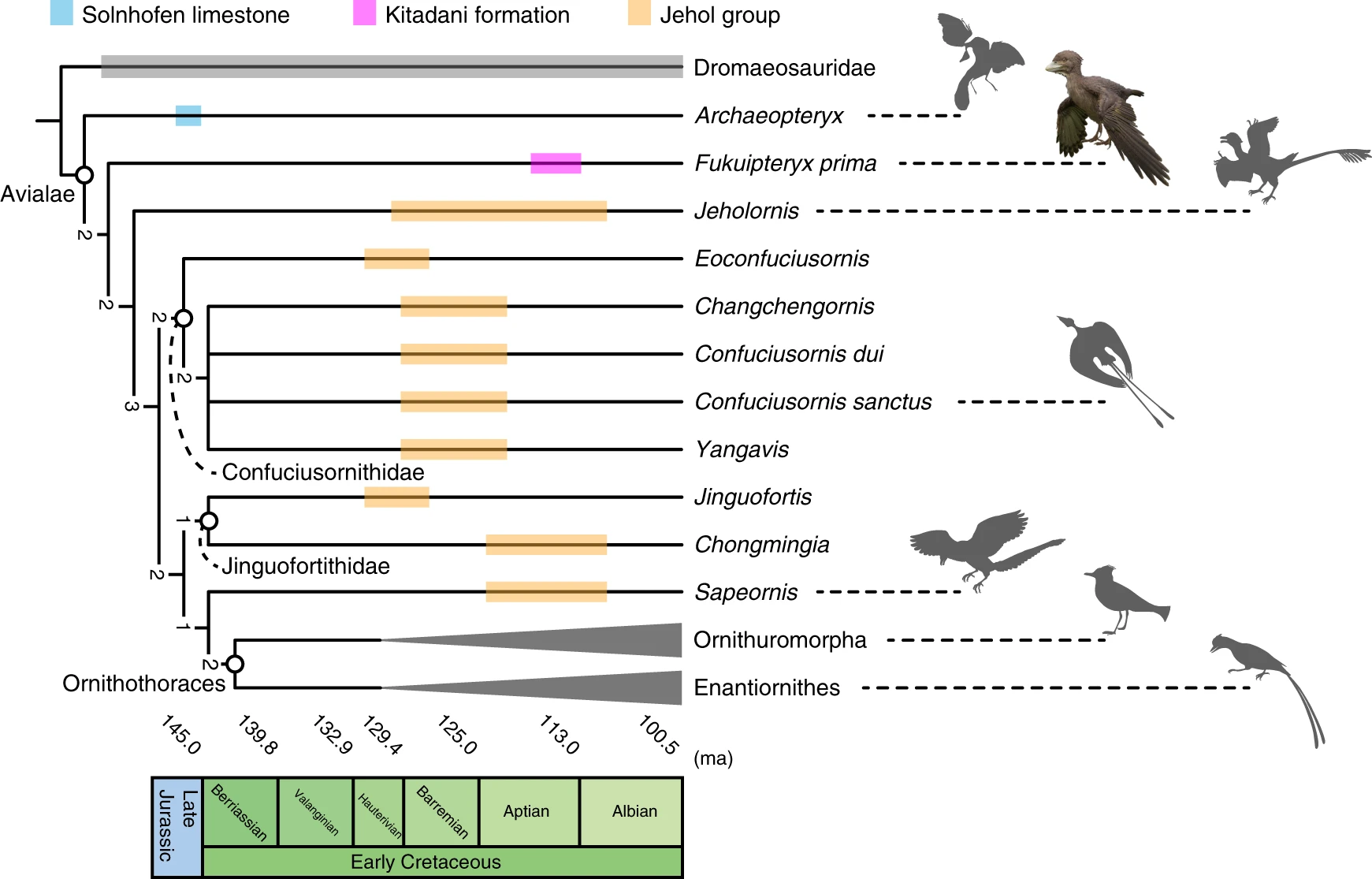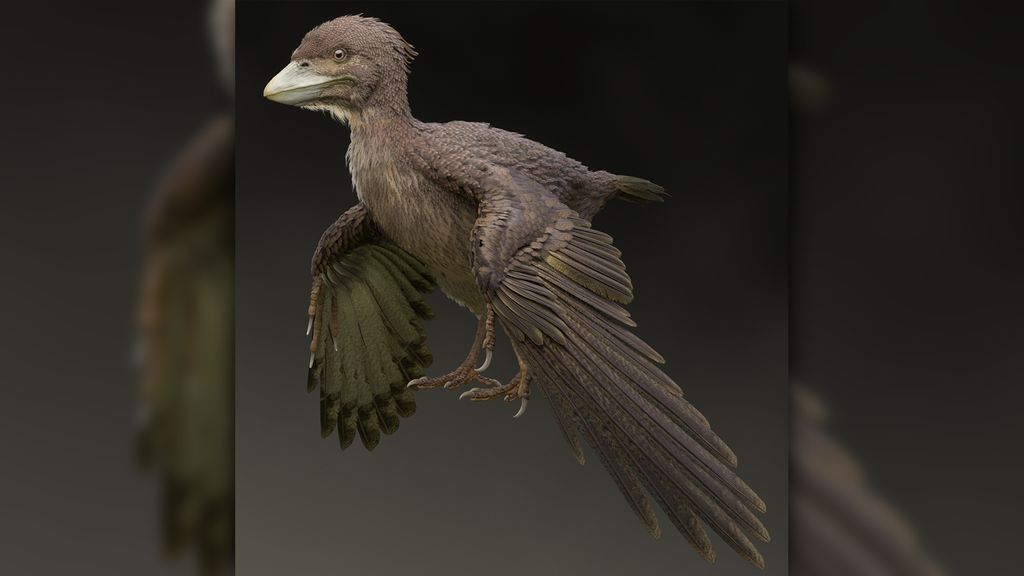Post by Eaglehawk on Nov 15, 2019 5:55:12 GMT
Fukuipteryx prima
Temporal range: Early Cretaceous
Scientific classification
Kingdom: Animalia
Phylum: Chordata
Clade: Dinosauria
Order: Saurischia
Suborder: Theropoda
Clade: Paraves
Clade: Eumaniraptora
Clade: Avialae Gauthier, 1986
Genus: Fukuipteryx
Species: Fukuipteryx prima
Etymology
Fukui refers to Fukui Prefecture in central Japan, where the specimen was collected, and pteryx (Latin) for wing; prima (Latin) for primitive, as the species exhibits several primitive morphological features among fossil birds.

FPDM-V-9769. a Photograph. A box indicates where a sample was taken for osteohistological analyses. b Schematic line drawing of the skeletons. Abbreviations: cev cervical vertebra, co coracoid, dv dorsal vertebra, fe femur, fu furcula, hu humerus, il ilium, mc metacarpal, md manual digit, py pygostyle, ra radius, sv sacral vertebra, ti tibia, ul ulna. Scale bars equal 3 cm in a and b
Holotype
FPDM-V-9769, a disarticulated but closely associated skeleton, including right surangular; two cervicals; four dorsals including two nearly complete ones, an isolated centrum, and incomplete vertebral arch; incomplete synsacrum composed of two sacrals; five caudals; pygostyle; several dorsal ribs; incomplete furcula; incomplete left and right coracoids; incomplete right ilium; forelimbs including left humerus, incomplete left and complete right ulna, complete left and incomplete right radius, right major metacarpal, left minor metacarpal, left alular digit 1, left major digits 2 and 3, minor digits 3 and 4; and hindlimbs including left and right femur; left and right incomplete tibia; and variably preserved metatarsals II (left), III (incomplete left), and IV (complete left and incomplete right).

Simplified strict consensus tree of 1264 most parsimonious trees with a length of 1323, resulting from analyses with an addition of FPDM-V-9769 to a matrix on fossil birds16. Numbers near each node denote bremer support values. Note that Fukuipteryx prima represents the only Early Cretaceous non-ornithothoracine avialan collected outside of the Jehol Group. Silhouette drawings for Mesozoic birds were created by M.W. Life restoration of F. prima was created by M. Yoshida
Dinosaur-Era Bird Preserved in 3D Could Rewrite History of Flight
By Mindy Weisberger - Senior Writer 12 hours ago Animals
The fossil dates to 120 million years ago.

Life restoration of Fukuipteryx prima. (Image: © Masanori Yoshida)
Around 120 million years ago, a bird about the size of a pigeon fluttered through Cretaceous forests in what is now Japan. The newly discovered fossil, preserved in three dimensions, is the first primitive Cretaceous bird found outside China. And it may force scientists to rethink some details in the evolution of flight.
The ancient avian, named Fukuipteryx prima, displays something found in modern birds that is absent in other early Cretaceous bird fossils: a bony plate near the tail.
Known as a pygostyle, this triangular structure supports tail feathers and has been linked to the evolution of shorter tails for flying. But researchers now suspect that even though this plate emerged as tails became smaller, it isn't necessarily a flight adaptation, according to a new study.
Scientists found the partial skeleton of the bird in Kitadani Dinosaur Quarry, a Lower Cretaceous formation near the city of Katsuyama in central Japan.
What distinguishes birds such as Fukuipteryx from their nonavian dinosaur cousins? They have forelimbs longer than their hind limbs, unfused shoulder bones and a shortened tail with a pygostyle, said lead study author Takuya Imai, an assistant professor with the Dinosaur Research Institute at Fukui Prefectural University in Fukui, Japan.
Though some nonavian dinosaurs may have one of these features, only birds have all three, Imai told Live Science in an email.
Like Archaeopteryx — the oldest known bird, dating to 160 million to 140 million years ago — Fukuipteryx had an unfused pelvis and a U-shaped wishbone: hallmarks of primitive birds. Other intact bones in the fossil included ribs, vertebrae and limb bones, as well as the pygostyle, which was "long, robust and rod-shaped" and ended with "a paddle-like structure," the researchers reported.
In some aspects, Fukuipteryx's pygostyle shape resembled that of a domestic chicken, the scientists wrote.
Previously, it was thought that birds' tails shortened as the animals adapted to flight. But Fukuipteryx is a more primitive bird than the last of the long-tailed flyers, a genus called Jeholornis that lived in China around 122 million to 120 million years ago, Imai said. This suggests that the loss of long tails, and the appearance of the pygostyle, may not be linked to flight.
"We still need more evidence to clarify this," he said.
Prior to this discovery, the only bird fossils from the early Cretaceous came from northeastern China, offering an incomplete view of how birds' distinctive adaptations emerged in the avian family tree, the study said.
"New findings from Japan and other regions in the world may completely change the picture again about what we think of the evolution of flight in the birds," Imai added.
The findings were published online today (Nov. 14) in the journal Communications Biology.
www.livescience.com/cretaceous-pigeon-fukuipteryx.html
Journal Reference:
Imai, T., Azuma, Y., Kawabe, S. et al. An unusual bird (Theropoda, Avialae) from the Early Cretaceous of Japan suggests complex evolutionary history of basal birds. Commun Biol 2, 399 (2019) doi:10.1038/s42003-019-0639-4
Abstract
The Early Cretaceous basal birds were known largely from just two-dimensionally preserved specimens from north-eastern China (Jehol Biota), which has hindered our understanding of the early evolution of birds. Here, we present a three-dimensionally-preserved skeleton (FPDM-V-9769) of a basal bird from the Early Cretaceous of Fukui, central Japan. Unique features in the pygostyle and humerus allow the assignment of FPDM-V-9769 to a new taxon, Fukuipteryx prima. FPDM-V-9769 exhibits a set of features comparable to that of other basalmost birds including Archaeopteryx. Osteohistological analyses indicate that FPDM-V-9769 is subadult. Phylogenetic analyses resolve F. prima as a non-ornithothoracine avialan basal to Jeholornis and outgroup of the Pygostylia. This phylogenetic result may imply a complex evolutionary history of basal birds. To our knowledge, FPDM-V-9769 represents the first record of the Early Cretaceous non-ornithothoracine avialan outside of the Jehol Biota and increases our understanding of their diversity and distribution during the time.
www.nature.com/articles/s42003-019-0639-4?utm_source=commission_junction&utm_medium=affiliate
Temporal range: Early Cretaceous
Scientific classification
Kingdom: Animalia
Phylum: Chordata
Clade: Dinosauria
Order: Saurischia
Suborder: Theropoda
Clade: Paraves
Clade: Eumaniraptora
Clade: Avialae Gauthier, 1986
Genus: Fukuipteryx
Species: Fukuipteryx prima
Etymology
Fukui refers to Fukui Prefecture in central Japan, where the specimen was collected, and pteryx (Latin) for wing; prima (Latin) for primitive, as the species exhibits several primitive morphological features among fossil birds.

FPDM-V-9769. a Photograph. A box indicates where a sample was taken for osteohistological analyses. b Schematic line drawing of the skeletons. Abbreviations: cev cervical vertebra, co coracoid, dv dorsal vertebra, fe femur, fu furcula, hu humerus, il ilium, mc metacarpal, md manual digit, py pygostyle, ra radius, sv sacral vertebra, ti tibia, ul ulna. Scale bars equal 3 cm in a and b
Holotype
FPDM-V-9769, a disarticulated but closely associated skeleton, including right surangular; two cervicals; four dorsals including two nearly complete ones, an isolated centrum, and incomplete vertebral arch; incomplete synsacrum composed of two sacrals; five caudals; pygostyle; several dorsal ribs; incomplete furcula; incomplete left and right coracoids; incomplete right ilium; forelimbs including left humerus, incomplete left and complete right ulna, complete left and incomplete right radius, right major metacarpal, left minor metacarpal, left alular digit 1, left major digits 2 and 3, minor digits 3 and 4; and hindlimbs including left and right femur; left and right incomplete tibia; and variably preserved metatarsals II (left), III (incomplete left), and IV (complete left and incomplete right).

Simplified strict consensus tree of 1264 most parsimonious trees with a length of 1323, resulting from analyses with an addition of FPDM-V-9769 to a matrix on fossil birds16. Numbers near each node denote bremer support values. Note that Fukuipteryx prima represents the only Early Cretaceous non-ornithothoracine avialan collected outside of the Jehol Group. Silhouette drawings for Mesozoic birds were created by M.W. Life restoration of F. prima was created by M. Yoshida
Dinosaur-Era Bird Preserved in 3D Could Rewrite History of Flight
By Mindy Weisberger - Senior Writer 12 hours ago Animals
The fossil dates to 120 million years ago.

Life restoration of Fukuipteryx prima. (Image: © Masanori Yoshida)
Around 120 million years ago, a bird about the size of a pigeon fluttered through Cretaceous forests in what is now Japan. The newly discovered fossil, preserved in three dimensions, is the first primitive Cretaceous bird found outside China. And it may force scientists to rethink some details in the evolution of flight.
The ancient avian, named Fukuipteryx prima, displays something found in modern birds that is absent in other early Cretaceous bird fossils: a bony plate near the tail.
Known as a pygostyle, this triangular structure supports tail feathers and has been linked to the evolution of shorter tails for flying. But researchers now suspect that even though this plate emerged as tails became smaller, it isn't necessarily a flight adaptation, according to a new study.
Scientists found the partial skeleton of the bird in Kitadani Dinosaur Quarry, a Lower Cretaceous formation near the city of Katsuyama in central Japan.
What distinguishes birds such as Fukuipteryx from their nonavian dinosaur cousins? They have forelimbs longer than their hind limbs, unfused shoulder bones and a shortened tail with a pygostyle, said lead study author Takuya Imai, an assistant professor with the Dinosaur Research Institute at Fukui Prefectural University in Fukui, Japan.
Though some nonavian dinosaurs may have one of these features, only birds have all three, Imai told Live Science in an email.
Like Archaeopteryx — the oldest known bird, dating to 160 million to 140 million years ago — Fukuipteryx had an unfused pelvis and a U-shaped wishbone: hallmarks of primitive birds. Other intact bones in the fossil included ribs, vertebrae and limb bones, as well as the pygostyle, which was "long, robust and rod-shaped" and ended with "a paddle-like structure," the researchers reported.
In some aspects, Fukuipteryx's pygostyle shape resembled that of a domestic chicken, the scientists wrote.
Previously, it was thought that birds' tails shortened as the animals adapted to flight. But Fukuipteryx is a more primitive bird than the last of the long-tailed flyers, a genus called Jeholornis that lived in China around 122 million to 120 million years ago, Imai said. This suggests that the loss of long tails, and the appearance of the pygostyle, may not be linked to flight.
"We still need more evidence to clarify this," he said.
Prior to this discovery, the only bird fossils from the early Cretaceous came from northeastern China, offering an incomplete view of how birds' distinctive adaptations emerged in the avian family tree, the study said.
"New findings from Japan and other regions in the world may completely change the picture again about what we think of the evolution of flight in the birds," Imai added.
The findings were published online today (Nov. 14) in the journal Communications Biology.
www.livescience.com/cretaceous-pigeon-fukuipteryx.html
Journal Reference:
Imai, T., Azuma, Y., Kawabe, S. et al. An unusual bird (Theropoda, Avialae) from the Early Cretaceous of Japan suggests complex evolutionary history of basal birds. Commun Biol 2, 399 (2019) doi:10.1038/s42003-019-0639-4
Abstract
The Early Cretaceous basal birds were known largely from just two-dimensionally preserved specimens from north-eastern China (Jehol Biota), which has hindered our understanding of the early evolution of birds. Here, we present a three-dimensionally-preserved skeleton (FPDM-V-9769) of a basal bird from the Early Cretaceous of Fukui, central Japan. Unique features in the pygostyle and humerus allow the assignment of FPDM-V-9769 to a new taxon, Fukuipteryx prima. FPDM-V-9769 exhibits a set of features comparable to that of other basalmost birds including Archaeopteryx. Osteohistological analyses indicate that FPDM-V-9769 is subadult. Phylogenetic analyses resolve F. prima as a non-ornithothoracine avialan basal to Jeholornis and outgroup of the Pygostylia. This phylogenetic result may imply a complex evolutionary history of basal birds. To our knowledge, FPDM-V-9769 represents the first record of the Early Cretaceous non-ornithothoracine avialan outside of the Jehol Biota and increases our understanding of their diversity and distribution during the time.
www.nature.com/articles/s42003-019-0639-4?utm_source=commission_junction&utm_medium=affiliate


